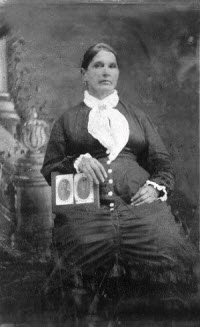Annotation:Quindaro Hornpipe: Difference between revisions
m (Text replacement - "garamond, serif" to "sans-serif") |
No edit summary |
||
| Line 1: | Line 1: | ||
{{TuneAnnotation | |||
|f_tune_annotation_title=https://tunearch.org/wiki/Annotation:Quindaro_Hornpipe > | |||
|f_annotation='''QUINDARO HORNPIPE.''' AKA - "[[Quindaro]]," “[[Qumdaro]].” AKA and see "[[Boston Fancy (2)]]." American, Scottish; Hornpipe or (seldom) Reel. USA, New England. G Major. Standard tuning (fiddle). AABB (most versions): AA'BB (Kerr). New York City writer, researcher and musician Don Meade finds the tune was named for a Kansas town founded by abolitionists in 1856, and subsequently abandoned. New Hampshire fiddler Randy Miller expands on the origins of the name: | |||
'''QUINDARO HORNPIPE.''' AKA - "[[Quindaro]]," “[[Qumdaro]].” AKA and see "[[Boston Fancy (2)]]." American, Scottish; Hornpipe or (seldom) Reel. USA, New England. G Major. Standard tuning (fiddle). AABB (most versions): AA'BB (Kerr). New York City writer, researcher and musician Don Meade finds the tune was named for a Kansas town founded by abolitionists in 1856, and subsequently abandoned. New Hampshire fiddler Randy Miller expands on the origins of the name: | |||
[[File:quindarobrown.jpg|300px|thumb|left|Quindaro Brown]] | [[File:quindarobrown.jpg|300px|thumb|left|Quindaro Brown]] | ||
<blockquote> | <blockquote> | ||
| Line 14: | Line 13: | ||
</blockquote> | </blockquote> | ||
Burchenal prints it as a tune for the dance "Boston Fancy." See also the similar “[[Douglas Hornpipe]].” Seattle musician, entrepreneur and researcher Vivian Williams finds a slightly different version appears under the name "[[Fanny's Delight]]" in '''Saunders School for the Violin''' (Providence, R.I., 1847). | Burchenal prints it as a tune for the dance "Boston Fancy." See also the similar “[[Douglas Hornpipe]].” Seattle musician, entrepreneur and researcher Vivian Williams finds a slightly different version appears under the name "[[Fanny's Delight]]" in '''Saunders School for the Violin''' (Providence, R.I., 1847). | ||
|f_source_for_notated_version=fiddler Pete Sutherland (Vt) [Phillips]. | |||
|f_printed_sources=Burchenal ('''American Country Dances, vol. 1'''), 1918; pp. 39 40 (appears as "Boston Fancy" [2]). Cole ('''1000 Fiddle Tunes'''), 1940; p. 104. Ford ('''Traditional Music in America'''), 1940; p. 117. Kerr ('''Merry Melodies, vol. 2'''), c. 1880's; No. 367, p. 40 (appears as "Qumdaro"). Kerr ('''Merry Melodies for the Piano'''), p. 28. Miller & Perron ('''New England Fiddler’s Repertoire'''), 1983; No. 120. Phillips ('''Traditional American Fiddle Tunes'''), vol. 2, 1995; p. 217. '''Ryan’s Mammoth Collection''', 1883; p. 139. Songer ('''Portland Collection'''), 1997; p. 163. Spadaro ('''10 Cents a Dance'''), 1980; p. 41. Tolman ('''The Nelson Music Collection'''), 1969; p. 13. '''White’s Unique Collection''', 1896; No. 135, p. 24. | |||
|f_recorded_sources=Biograph 6007, Ebenezer - "Tell It To Me." Whistler’s Music 9859, Sarah Bauhan - “Chasing the New Moon” (1991). | |||
|f_see_also_listing=Jane Keefer's Folk Music Index: An Index to Recorded Sources [http://www.ibiblio.org/keefer/q01.htm#Quiho]<br> | |||
}} | |||
------------- | |||
Jane Keefer's Folk Music Index: An Index to Recorded Sources [http://www.ibiblio.org/keefer/q01.htm#Quiho]<br> | |||
---- | |||
Revision as of 04:34, 11 April 2020
X:1 T:Quindaro Hornpipe L:1/8 M:C| K:G gf|g2G2G2BG|FA DF G2Bc|dB ed cB AG|FG AF D2gf| g2G2G2BG|FA DF G2AB|ce dc BA GF|G2B2G2:| |:dc|Bg Bc d2cB|ca AB c2BA|Bd ed cB AG|FA D2D2ga| bg fg dg fg|bg fg dg fg|ed cB AG FA|G2B2G2:|]
QUINDARO HORNPIPE. AKA - "Quindaro," “Qumdaro.” AKA and see "Boston Fancy (2)." American, Scottish; Hornpipe or (seldom) Reel. USA, New England. G Major. Standard tuning (fiddle). AABB (most versions): AA'BB (Kerr). New York City writer, researcher and musician Don Meade finds the tune was named for a Kansas town founded by abolitionists in 1856, and subsequently abandoned. New Hampshire fiddler Randy Miller expands on the origins of the name:

Quindaro Brown was the daughter of Adam Brown, a Chief of the Ohio Wyandot Tribe. In traditional Wyandot, “Quindaro” refers to the leadership role of a first born daughter; it is “also a word that some interpret by the adage ‘In union there is strength.’ At the time of the Wyandot’s forced removal to Kansas in the 1840s, Abelard Guthrie, a U.S. Land Office agent, fell in love with Quindaro Brown and married her. In Kansas, Quindaro was able to convince her tribespeople to sell land to a company for a townsite in present-day Kansas City. The town of Quindaro was the first Free-State port on the Missouri River, an underground railroad site and a temperance town. At the time of its founding in 1856, it was a beacon of hope for anti-slavery advocates in a sea of pro-slavery adherents. The Quindaro townsite was listed on the National Register of Historic Places in 2002. The tune seems to commemorate the town and its namesake. ... [Randy Miller, Monadnock Folklore Society webpage, 2008] [1].
Burchenal prints it as a tune for the dance "Boston Fancy." See also the similar “Douglas Hornpipe.” Seattle musician, entrepreneur and researcher Vivian Williams finds a slightly different version appears under the name "Fanny's Delight" in Saunders School for the Violin (Providence, R.I., 1847).

